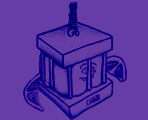
FatBat Software
Boinc
Fatbat has helped bring the BOINC technology to CERN.
BOINC allows people to donate their spare computer power to a project, or for a company to harness the unused computer resources on their desktop PCs. You can learn more about Boinc and the projects Fatbat has been involved in under Boinc links.
Guide to Massive Distributed Computing
20. Sep. 2009
Introduction
Coming soon.
Volunteer Computing
Public Computing, Public Resource Computing, or Volunteer Computing is a style of distrubuted computing that harnesses the power of volunteers. The volunteers work on the problem either directly or by donating their own computer's spare cycles.
The first project to explore this idea was the great internet mersenne prime search, but the project that really showed the promise of this type of distributed computing was Seti@Home. Seti@Home let the general public download a screensaver that would search for extra-terrestrial radio signals when they were not using their computer. From a modest beginning Seti@Home has grown to one of the most powerful supercomputers in the world. At the moment it is able to deliver 684 TeraFlops sustained.
The Seti project realized that there was much more power available than they could use themselves, so they set about creating a general framework for Volunteer Computing that would allow other scientific projects to profit from this approach. This framework called Berkeley Open Infrastructure for Network Computing or BOINC now hosts more than 20 scientific projects ranging from beam stability studies in the LHC to modeling the spread of malaria in Africa. The BOINC framework has a total computational capacity of 2300 TeraFLOPS, or two times that of the fastest supercomputer in the world.
Following the success of BOINC projects have also started recruiting the help of volunteers directly insted of just their computers. Galaxy Zoo for example uses volunteers to classify galaxies.
Map/Reduce
Coming soon.
Grid
Coming soon.
Cloud
Coming soon.
